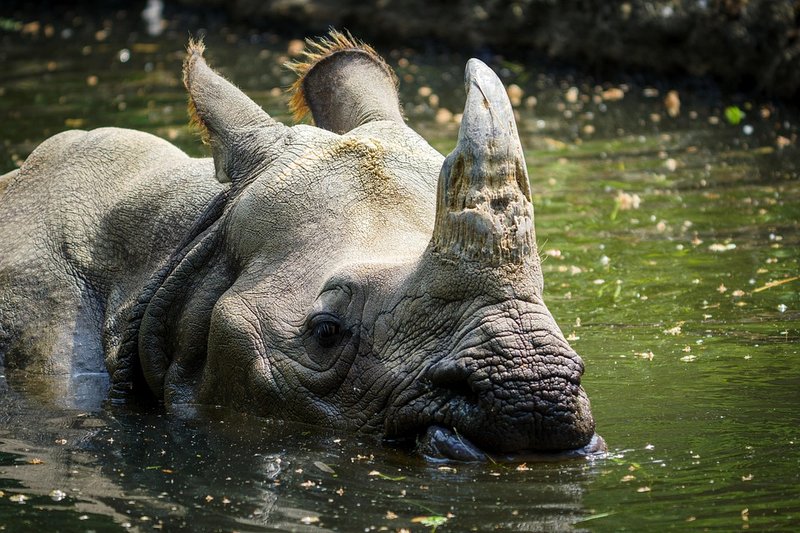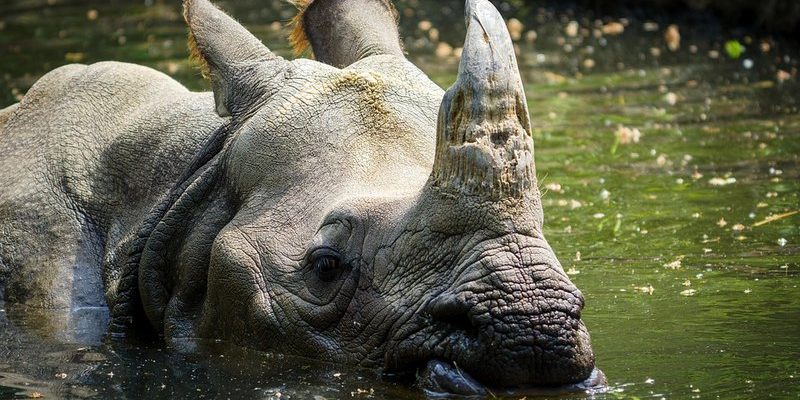
Now, you might be wondering why it matters to separate fact from fiction. Well, when we genuinely understand these creatures, we can better appreciate their role in the ecosystem and the conservation efforts needed to protect them. So, let’s dive into some common myths and misconceptions about the Indian rhinoceros and set the record straight.
Myth 1: All Rhinoceroses Have Two Horns
When people think of rhinoceroses, many imagine the two-horned species, like the white and black rhinos. However, the Indian rhinoceros is unique in that it has only one horn. Its single horn can grow up to 24 inches long and is primarily made of keratin—the same material that makes up our hair and nails.
You might be surprised to learn that the one-horned rhino’s horn isn’t just for show. They use it for several purposes, such as fighting for territory or attracting mates. However, this singular horn has also led to misconceptions, with some people thinking that all rhinos are alike. The truth is that each species of rhinoceros has distinct characteristics that help them thrive in their specific habitats.
Myth 2: Indian Rhinos Are Aggressive and Dangerous
There’s a notion that Indian rhinos are aggressive creatures just waiting to charge at any sign of danger. While they are large and powerful animals, they are not inherently aggressive. In fact, Indian rhinos are more withdrawn and tend to avoid encounters with humans whenever possible.
Here’s the thing: they’re often seen as grumpy because of their size and appearance, but their defensive behavior is typically a reaction to feeling threatened. They prefer to stay alone or in small groups, grazing peacefully on grasses and leaves. So, if you see one in the wild, it’s best to admire from a distance rather than think of it as an angry giant.
Myth 3: Indian Rhinos Can’t See Well
Another common myth is that Indian rhinos have poor eyesight. It’s true that they don’t have the keenest vision, but that doesn’t mean they can’t see at all! They’ve adapted well to their environment and rely on other senses, such as hearing and smell, to navigate their surroundings. In fact, their sense of smell is highly developed, allowing them to detect predators or fellow rhinos from miles away.
You might find yourself wondering how they cope in dense forests where visibility can be limited. Their ability to be aware of their surroundings through smell and sound helps them thrive in these areas. So, while they may not spot a camouflaged animal across the street, they are far from blind!
Myth 4: Indian Rhinos Are Not Endangered
Some people believe that because Indian rhinos are often featured in wildlife documentaries, they must be thriving. However, this couldn’t be further from the truth. The reality is that Indian rhinos are classified as vulnerable, and their numbers have significantly decreased due to habitat loss, poaching, and climate change.
Conservation efforts are crucial for their survival, including protected areas and anti-poaching measures. It’s a bit like having a beloved pet that you want to keep safe; if you don’t take care of their environment, they won’t thrive. So, it’s essential for us to support initiatives that help protect these magnificent creatures before it’s too late.
Myth 5: Indian Rhinos Only Live in India
While it’s in the name, Indian rhinoceroses can actually be found in other countries as well. Yes, they are primarily associated with India, specifically in the Kaziranga National Park and other reserves. However, they also inhabit parts of Nepal and have been introduced to areas in Kazakhstan and other regions.
You might think of them like tourists; they might have specific hotspots they prefer, but they can be found in various destinations. Their adaptability has allowed them to survive in different environments, as long as there’s enough food and protection from poachers.
Myth 6: Indian Rhinos Are Just Big Animals
Lastly, many people overlook the ecological importance of Indian rhinoceroses. They might seem like just large animals taking up space, but they actually play a vital role in their ecosystem. Their grazing habits help shape the landscape, allowing various plant species to thrive.
By consuming large amounts of grass, they create a more diverse habitat for other animals. You can think of them as nature’s gardeners. Without them, the ecosystems they inhabit could suffer, potentially affecting numerous other species. So next time you think of an Indian rhino as just a big creature, remember the big impact they have!
There you have it—the truth behind some of the most common myths and misconceptions about the Indian rhinoceros. These magnificent creatures are so much more than we often give them credit for. By debunking these myths, we can foster a deeper understanding and appreciation for them, ultimately paving the way for more effective conservation efforts.
Whether you’re an avid wildlife enthusiast or just starting to learn about these amazing animals, remember that facts are your best friends. Understanding the truth about the Indian rhinoceros not only enriches our knowledge but also helps to secure a future for them in the wild. So let’s continue to support conservation efforts and spread awareness about these unique beings!

